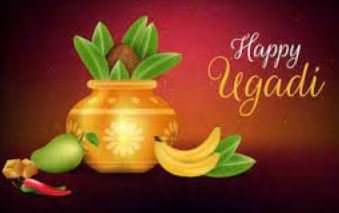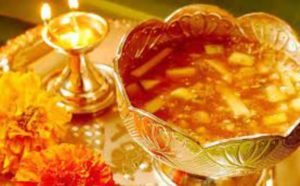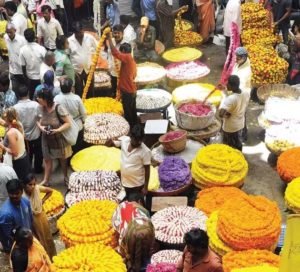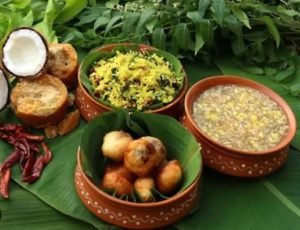Ugadi: “The South India’s New Year”


Ugadi, the famous South Indian festival is celebrated with full enthusiasm to welcome the New Year according to the Indian Lunar calendar. This festival is mainly celebrated in the States of Karnataka and Andhra Pradesh to usher in the season of freshness and brightness before the beautiful colors of Holi from North India fade away entirely.
The word Ugadi is derived from two different words; “Yuga’ which means “Age” in Sanskrit and ‘Adi’ which means “Beginning” in both Sanskrit and Kannada. This day is also known as “Chandramana Ugadi”.
Ugadi which is the beginning of the New Year falls in Chaitra month according to the Hindu Lunar calendar and usually falls in March and April (as per the Gregorian calendar).
In Hinduism, Ugadi has an age-old association with their scriptures.

Ugadi is honored as the day Rama was officially crowned king, a moment that symbolized the victory of good over evil, and the beginning of auspicious times for the elated citizens of Ayodhya.
Thus, Ugadi refers specifically to the Yuga in our people’s lives i.e., the Kaliyuga. It is also referred to as Chaitra “Suddha Padyami” according to Hindu religious texts.
The cosmic calculations made by Bhaskar Acharya, a noted Indian mathematician, mentioned that the first day of the first month of a new year will begin with the Ugadi festivity.
Not to mention, Ugadi also coincides with the onset of spring and the harvest season.
Although the Ugadi festival is regional to states of Karnataka and Andhra Pradesh it is also celebrated in different states of India by their different names.

The different names of the Ugadi festival are: –
Only in the state of Andhra Pradesh, Ugadi is known by sixty different names.
Telugu Ugadi names are:-
Prabhava, Vibhava, Sukla, Pramodyuta, Prajothpatti, Angīrasa, Srīmukha, Bhāva, Yuva, Dhāta, Īswara, Bahudhānya, Pramādhi, Vikrama, Chitrabhānu, Vrisha,Svabhānu, Tārana, Pārthiva, Vyaya, Sarvajit, Sarvadhāri, Virodhi, Vikruti, Khara, Nandana, Vijaya, Jaya Manmadha, Durmukhi, Hevalambi, Vilambi, Vikāri, Sārvari, Plava, Subhakrit, Sobhakrit, Krodhi, Viswāvasu, Parābhava, Plavanga, Kīlaka, Soumya, Sādhārana, Virodhikrit, Paridhāvi, Pramādi, Ānanda, Rakshasa, NaLa, Pingala, Kālayukti, Siddhārtha, Roudri, Durmathi, Dundubhi, Rudhirodgāri, Raktākshi, Krodhana, and Akshaya.
This festival is rich in color, and flora that marks the advent of spring and the commencement of the New Year, and there are various regional names of Ugadi festival.
The festive ceremonies of Ugadi are observed in harmony with the joy and beauty of nature to mark the beginning of growth, affluence, and prosperity for everyone.
Before the beginning of Chaitra month, people cleaned and whitewashed their homes and decorated temples as well as the deity rooms in their homes with jasmine flowers and mango leaves.

On this day, people wake up before the sunrise. They start the Ugadi day with a holy oil bath early in the morning and wear new clothes.
The idols of gods and goddesses within the house are then bathed in oil too, after which prayers and offerings of neem flowers, mango, and tamarind are given up. The elderly women in the family then apply oil and vermilion to the forehead of the younger members following which all members of the family watch their reflection in a vessel of molten ghee.
The entire family worships the “Panchang” or the new Hindu almanac which is read for the first time. It is believed that special blessings are bestowed on those who read and listen to the Panchang.
Traditionally, the men are dressed in a white or off-white linen shirt paired with a cotton lungi or long loin cloth that is embellished with Gold Zari. While visiting the temple, men also don the “Angavastram”, which is a rectangular cloth of a similar color and embellishment. In recent times, however, some men prefer wearing new shirts and trousers. Men also prefer to wear a gold chain and a gold wristwatch irrespective of what attire they wear on this auspicious day.
Women wear opulent clothes during this day such as brocade sarees like Bangalore silk or Kanjivaram silk which is rich in colors with thick gold Zari borders. They accessorize by adorning their hair with jasmine flowers. Women prefer heavy Jewelry consisting of pure gold necklaces, earrings, and bangles in traditional motifs.
Even the young girls in the family dress elaborately in silk Lehenga Cholis. The ensemble is completed with strings of jasmine flowers in the hair and jewelry such as pearl necklaces, mang tikkas, and gold earrings.
However, a more contemporary style of this is when women and young girls prefer to wear cotton sarees in traditional gold Zari designs or colorful threadwork. The accessories are also very contemporary in terms of sporting costume jewelry.
Women also draw beautiful rangoli in the form of floral designs, as an auspicious mark of the festivity, on the space just outside their homes.
The main entrance, doors, and windows of houses as well as shops are decorated with strings of fresh green mango leaves called “Thoran”.
According to Hindu scriptures Lord Ganesh, “God of wealth and prosperity”, is fond of mango leaves, this tradition signifies good harvest and good health. The people visit temples to seek divine blessings for health, wealth, success, and prosperity in the New Year.

The day is started with lots of rituals and needless to mention that each ritual followed on Ugadi day, has its significance. Whether it’s hanging mango leaves and placing a kalash near the door or the calling of the priest to make the yearly forecast are all part of Ugadi significance and symbolism.
As in every Indian festival, people shop heavily during the months preceding Chaitra which is the first month in the Hindu calendar. This day is celebrated with fervor and is also regarded as the “Herald of the Harvest Season”.
Kavi Sammelanam (Poeat Congregation) is also organized within different areas and is considered one of the major Ugadi festival activities where people engage themselves in literary discussions and recite poems.
Ugadi is honored by many as the day Rama was officially crowned king, a moment that symbolized the victory of good over evil, and the beginning of auspicious times for the elated citizens of Ayodhya.
Ugadi, the New Year for the people living in the Deccan area also celebrates the arrival of spring season.
This auspicious day involves religious observances and traditions.
The festival also marks when mother nature brims with sprightliness of different colors of flowers blossom all over and mango buds bloom heralding the arrival of New Year for people of Southern India.
This is the time of the year when the entire nature appears to be drowned in the festive spirit and there lies the spiritual significance of Ugadi.

Like the new leaves, new buds, fresh breeze, and bright sunlight, the Ugadi festival also symbolizes the birth of a new era.
It is celebrated on Shukla Paksha (bright fortnight) of the first month Chaitra of the Hindu calendar and also the first season, Vasanta –Ritu or Spring season. As all these elements work together, the Ugadi festival’s importance is very significant.
This day is also considered highly auspicious to start new ventures. However, all business transactions are carried out after certain religious observances that are said to bring good luck, wealth, and prosperity to believers.
Many delicacies are prepared during this festival but Ugadi Pachadi is the most popular among them. This dish is a fusion of various tastes.
The basic ingredients of the dish, Ugadi Pachadi are neem, jaggery, tamarind, mango, chili, and salt.
The six tastes of Ugadi Pachadi are sweet, sour, salty bitter, pungent, and spicy. These ingredients also reflect the six aspects or emotions of life.
During this time of year, the earth is seen blooming with many flowers, especially Jasmine in southern India.
These colorful blossoms symbolize growth and thus Jasmine is offered to Gods in the form of garlands.
There are many customs of the festival which are an integral part of Ugadi significance and symbolism. One such custom is the making of the dish “Ugadi Pachadi”.

The significance of Ugadi Pachadi is immense as it symbolizes the essence of life. This special dish is prepared with ingredients like:
The dish is significant as it has all the tastes of life. It teaches that life is a mixture of all the emotions.
The basic ingredients of the dish, Ugadi Pachadi are neem, jaggery, tamarind, mango, chili, and salt and all these ingredients contribute to human health benefits.
Thus, in an era of Kaliyuga that is often dominated by a culture of sex, money, envy, alcohol & drug intoxication, and last but not least the pursuit of power, Ugadi is a reminder to take advantage of authentic sages, who can uplift us during difficult times.
Wishing you all a Happy Ugadi
DISCLAIMER: The author is solely responsible for the views expressed in this article. The author carries the responsibility for citing and/or licensing of images utilized within the text.
